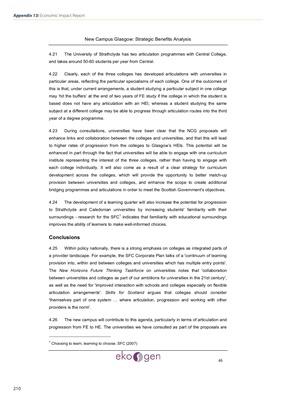
New Campus Glasgow: Strategic Benefits Analysis
46
4.21 The University of Strathclyde has two articulation programmes with Central College,
and takes around 50-60 students per year from Central.
4.22 Clearly, each of the three colleges has developed articulations with universities in
particular areas, reflecting the particular specialisms of each college. One of the outcomes of
this is that, under current arrangements, a student studying a particular subject in one college
may 'hit the buffers' at the end of two years of FE study if the college in which the student is
based does not have any articulation with an HEI, whereas a student studying the same
subject at a different college may be able to progress through articulation routes into the third
year of a degree programme.
4.23 During consultations, universities have been clear that the NCG proposals will
enhance links and collaboration between the colleges and universities, and that this will lead
to higher rates of progression from the colleges to Glasgow's HEIs. This potential will be
enhanced in part through the fact that universities will be able to engage with one curriculum
institute representing the interest of the three colleges, rather than having to engage with
each college individually. It will also come as a result of a clear strategy for curriculum
development across the colleges, which will provide the opportunity to better match-up
provision between universities and colleges, and enhance the scope to create additional
bridging programmes and articulations in order to meet the Scottish Government's objectives.
4.24 The development of a learning quarter will also increase the potential for progression
to Strathclyde and Caledonian universities by increasing students' familiarity with their
surroundings - research for the SFC1
indicates that familiarity with educational surroundings
improves the ability of learners to make well-informed choices.
Conclusions
4.25 Within policy nationally, there is a strong emphasis on colleges as integrated parts of
a provider landscape. For example, the SFC Corporate Plan talks of a 'continuum of learning
provision into, within and between colleges and universities which has multiple entry points'.
The New Horizons Future Thinking Taskforce on universities notes that 'collaboration
between universities and colleges as part of our ambitions for universities in the 21st century',
as well as the need for 'improved interaction with schools and colleges especially on flexible
articulation arrangements'. Skills for Scotland argues that colleges should consider
'themselves part of one system … where articulation, progression and working with other
providers is the norm'.
4.26 The new campus will contribute to this agenda, particularly in terms of articulation and
progression from FE to HE. The universities we have consulted as part of the proposals are
1 Choosing to learn, learning to choose. SFC (2007)
210
Appendix 13: Economic Impact Report